Reference no: EM13225903
Question 1
Which one of the following statements about lot-sizing rules is TRUE?
The periodic order quantity (POQ) rule seeks to create inventory remnants.
If the POQ rule is used, an item's lot size can vary each time an order is placed.
The lot-for-lot (L4L) rule is a special case of the fixed-order quantity (FOQ) rule.
All lot-sizing rules seek to minimize inventory levels.
Question 2
MRP explosion means estimating the total number of:
subassemblies, components, and raw materials needed for each parent item.
raw materials to be purchased from all suppliers.
parts to be produced for each parent item.
parts needed to be produced less the number of parts on hand for each parent item.
Question 3
Which one of the following is a feature of MRP II, but not available in basic MRP systems?
Financial reporting
Action notices
Dispatch lists
Capacity reporting
Question 4
The Big Mistake Company uses an MRP system. However, the company's database contains many inaccuracies. Which type of inaccuracy is most likely to result in incorrect planned order release quantities for its dependent demand items?
Incorrect routings
Incorrect bills of materials
Incorrect cost and pricing data
Incorrect machine capacity data
Question 5
Which of the following statements on MRP is TRUE?
The payoffs from MRP tend to be greater when there are more BOM levels and larger lot sizes.
When MRP systems are enhanced to include financial reporting, they are called basic MRP systems, or "little mrps."
The fixed-order quantity (FOQ) eliminates remnants.
MRP is an inventory control system that derives the gross requirements of the end items from purchase commitments with vendors.
Question 6
Use the following MRP record to answer the question.

What are the quantities of planned order releases for item XYZ for the first six weeks (weeks 1, 2, 3, 4, 5, and 6)?
35, 0, 0, 60, 0, 0
35, 0, 60, 0, 0, 0
5, 30, 0, 40, 20, 0
35, 0, 0, 40, 20, 0
Question 7
Table

Use the information in Table. In which week will the second planned order release occur?
Week 1
Week 2
Week 3
Week 4, 5, 6, 7, or 8
Question 8
Use the following MRP record to answer the question.

What will be the projected on-hand inventory quantity in week 7
Fewer than or equal to 30 units
Greater than 30 units but fewer than or equal to 60 units
Greater than 60 units but fewer than or equal to 90 units
Greater than 90 units
Question 9
Use the following MRP record to answer the question.

Which one of the following statements about item QRS is TRUE?
Two order releases are needed.
The first planned receipt occurs in week 1.
The second planned order release quantity is 90 units.
The total planned order release quantity (summing up all eight weeks) is 190 units.
Question 10
Table
Consider the following MPS, BOM, and inventory data. A blank MRP record is shown below.
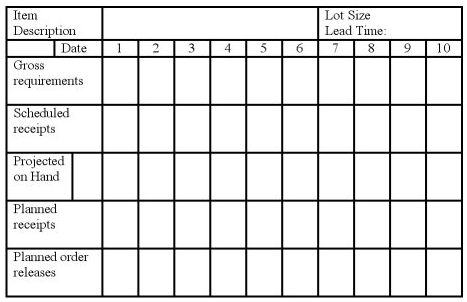
Master Production Schedule: The following table shows the MPS start quantities.

Bill of Material
Selected Inventory Data

Use the information in Table. Which one of the following statements about item C is TRUE?
It has a planned receipt of 80 units in week 3.
Its second planned order release is for 200 units in week 3.
It has a planned receipt of 180 units in week 6.
Its first planned order release is for 130 units in week 1.
Question 11
1.
Consider the following MPS, BOM, and inventory data. A blank MRP record is shown below.
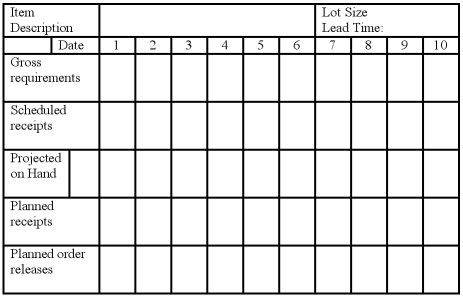
Master Production Schedule: The following table shows the MPS start quantities.

Bill of Material
Selected Inventory Data

Use the information in Table 15.2. Which one of the following statements about item F is TRUE?
The first planned order release is for 205 units in week 3.
There will be exactly one action notice, which calls for the delay of the scheduled receipt until week 2.
There will be exactly one action notice, which calls for the release of a new order.
Both 2 and 3 are correct.
Question 12
Table

Use the information in Table. Which one of the statements concerning item RST is TRUE?
The first planned receipt occurs in week 5.
There is an action notice needed to expedite the schedule receipt by one week.
The planned receipt in week 7 is 80 units.
There are exactly two planned order releases needed.
Question 13
Use the following MRP record to answer the question.

Which one of the statements concerning item LMN is TRUE?
There will be exactly two action notices needed.
The planned order release quantity in week 4 is 80 units.
The planned receipt quantity in week 6 is 30 units.
The projected on-hand inventory in week 8 is 70 units.
Question 14
Table

Use the information from Table. If an FOQ of 75 units is used, how many planned order releases are there for item XYZ?
Zero or one
Two or three
Four or five
More than five
Question 15

Use the information from Table. If a POQ lot-sizing rule is used, where P = 3, how many planned order releases are there for item XYZ?
Zero or one
Two or three
Four or five
More than five
Question 16
Management wishes to use a POQ lot-sizing rule for an item that experiences an average demand of 30 units per week. If the desired average lot size is 120 units, what should P be?
Zero or one weeks
Two or three weeks
Four or five weeks
More than five weeks
Question 17
Case Study
Sunshine Manufacture produces three products: X, Y, and Z. The production of these end items is controlled by an MRP system. Each end item X is assembled with two components of A and one component of B. Each end item of Y is assembled with two components of C and one component of A. End item Z is assembled from one unit of D and one unit of C; D is manufactured from one unit of A; and C is manufactured from one unit of B.
Use the information in Case Study. If level-by-level processing is used, what is a correct order for processing components A, B, C, and D?

Question 18
Table
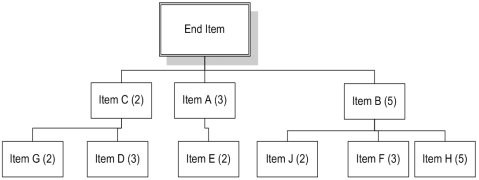
Viola Products produces one item with the following bill of materials

A recent check of their inventory reveals the following quantities on hand.
Use Table to answer this question. How many additional units of D are needed to produce 20 end items?
Fewer than 75
More than 75 but fewer than 95
More than 95 but fewer than 115
More than 115
Question 19
Table
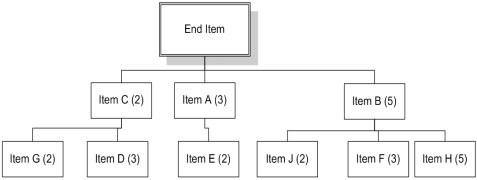
Viola Products produces one item with the following bill of materials

A recent check of their inventory reveals the following quantities on hand.
Use Table to answer this question. How many additional units of H are needed to produce 20 end items?
Fewer than 250
More than 250 but fewer than 350
More than 350 but fewer than 450
More than 450
Question 20
Table
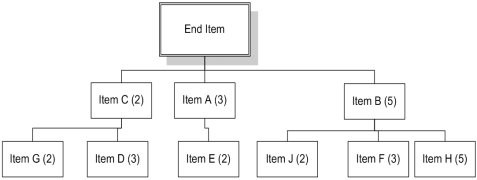
Viola Products produces one item with the following bill of materials

A recent check of their inventory reveals the following quantities on hand.
Use Table 15.5 to answer this question. How many additional units of G are needed to produce seven end items?
0
11
22
33
Question 21
Viola Products produces one item with the following bill of materials
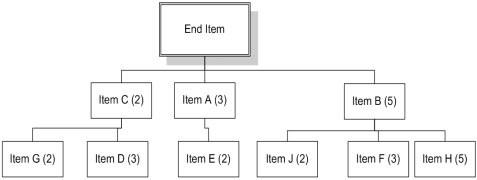
A recent check of their inventory reveals the following quantities on hand.

Use Table to answer this question. How many additional units of J are needed to produce seven end items?
25
36
47
58
Question 22
Which of the following is NOT used to derive an item's gross requirements?
The MPS for immediate parents that are end items
The planned order releases for parents below the MPS level
The MPS components that are not purchased items
Any other requirements not originating in the MPS, such as the demand for replacement parts
Question 23
A technique used for projecting time-phased capacity requirements for workstations is called:
capacity requirements planning.
time-adjusted output control.
input-output control.
work center planning.
Question 24
Which of the following uses of MRP in promoting a healthy environment is NOT used?
An MRP system can track waste in a bill of materials as a component of an item.
When the master production schedule is developed for a product, reports can be generated that project the quantity of waste.
When the master production schedule is developed for a product, reports can be generated that project the timing of waste.
The MRP system can be used to communicate directly with the International Organization for Standardization to file ISO 9000 documentation.
Question 25
In terms of resource planning, service goods must focus on maintaining:
dependent demand levels at a maximum.
capacity to serve customers.
off-line resources in order to serve customers.
independent demand resources at a maximum.
Question 26
An example of a dependent demand item in a service is a:
menu in a restaurant.
jukebox in a club.
operating suite at a hospital.
a pilot's checklist for an airline.
Question 27
The service analogy to the bill of materials in a manufacturing company is the:
bill of resources.
bill of services.
bill of sub-services.
bill of tender.